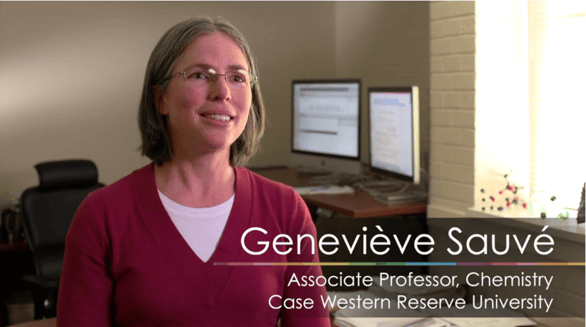
Today our 8000 Classrooms series takes us to the campus of Case Western Reserve University (CWRU) located in Cleveland, Ohio. CWRU is home to more than 10,000 students from all 50 states and from 91 countries. While shooting a video there recently documenting CWRU’s use of Echo360, we had the opportunity to meet Dr. Genevieve Sauvé. Dr. Sauvé is the Frank Hovorka Assistant Professor in Chemistry and has been on the faculty at CWRU for 6 years. Here she shares her experience using Echo360 to flip her classroom.
Tell us a little about how you use Echo360.
The reason I started using Echo360 is that I wanted to flip my class. Instead of teaching and lecturing in class, students watch my videos, do work before coming to class, and then in class, they work on problems and other activities.
Did you have to change anything about your teaching when you flipped your classroom?
Yes. Early on I realized it was a different experience for the student to be in a lecture hall versus sitting in front of a computer listening to a recorded lecture. I realized I needed to make the videos a little different and much shorter. So now I make [lecture] videos 5-10 minutes long. But, there are usually 2-3 videos the students need to view for each class.
The other thing that had to change was that “homework” that I would have assigned now became the “in-class” work. There was actually a lot that had to change: videos, pre-class questions, notes, in-class questions and activities.
Now my in-class activity is completely different. For example, I now walk around the class from table-to-table, answering student questions. If I realize that many of the students have the same questions, I stop the class and address the question. So, it’s very interactive.
How have the students responded?
Students are much more engaged because they have to participate and solve problems. They work in teams and they enjoy that. In the very beginning, the students were a bit unsure. They didn’t know how it all was going to work out. But by the first exam, they were sold! They thought it was a great way for me to teach because they did better than during my previous years [teaching the course]. Students also ask questions and show a comprehension that they didn’t in previous classes. So, overall I think it has been a success.
What motivated you to use Echo360 in the classroom?
I taught my courses in a very traditional way for five years. One thing that bothered me was that even if the student got an “A,” they would come to my office and ask questions that told me they didn’t really understand. So, I felt if they didn’t really understand then something was not quite right.
I began looking into more active types of learning. And I became an Active Learning Fellow here at Case Western Reserve University. I’m part of a group of 12 other fellows who are trying to use more active learning techniques when they teach. Being a part of that group has been very valuable for me. I have a support group so that I can talk about things that go well and things that don’t go well. I would have wasted a lot of time doing this on my own. It’s extremely valuable.
Were you nervous about using the technology? And if you were, how did you overcome your fears?
In the beginning, I definitely had some fears about using the technology. The first time I made a video, I literally repeated the same slide 20 times! But, I just got comfortable with the camera and technology. I just got used to it. I didn’t pay attention to how I looked or sounded. I just made sure the information was correct and explained well.
Is it fair to say that using the technology has made teaching more fun for you?
Yes, it makes teaching in the classroom a lot more fun! You’re interacting much more with the students.
Want to learn more? Watch the video to learn how Case Western Reserve University uses Echo360 to strategically improve student learning and outcomes.
Join the conversation about active learning online and follow us on Twitter, Facebook, and LinkedIn.

